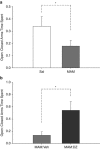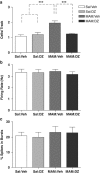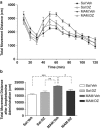Peripubertal diazepam administration prevents the emergence of dopamine system hyperresponsivity in the MAM developmental disruption model of schizophrenia
- PMID: 23612434
- PMCID: PMC3746684
- DOI: 10.1038/npp.2013.101
Peripubertal diazepam administration prevents the emergence of dopamine system hyperresponsivity in the MAM developmental disruption model of schizophrenia
Abstract
Schizophrenia is believed to arise from an interaction of genetic predisposition and adverse environmental factors, with stress being a primary variable. We propose that alleviating anxiety produced in response to stress during a sensitive developmental period may circumvent the dopamine (DA) system alterations that may correspond to psychosis in adults. This was tested in a developmental rat model of schizophrenia based on prenatal administration of the mitotoxin methyl azoxymethanol acetate (MAM). MAM administration leads to a hyperdopaminergic state consisting of an increase in the number of DA neurons firing spontaneously, which correlates with an increased behavioral response to amphetamine. MAM-treated rats exhibited a heightened level of anxiety during adolescence. Peripubertal administration of the antianxiety agent diazepam was found to prevent the increase in DA neuron activity and blunt the behavioral hyperresponsivity to amphetamine in these rats. These data suggest that the pathophysiological factors leading to the onset of psychosis in early adulthood may be circumvented by controlling the response to stress during the peripubertal period.
Figures




Similar articles
-
Amygdala Hyperactivity in MAM Model of Schizophrenia is Normalized by Peripubertal Diazepam Administration.Neuropsychopharmacology. 2016 Sep;41(10):2455-62. doi: 10.1038/npp.2016.42. Epub 2016 Mar 22. Neuropsychopharmacology. 2016. PMID: 27000940 Free PMC article.
-
Effects of pubertal cannabinoid administration on attentional set-shifting and dopaminergic hyper-responsivity in a developmental disruption model of schizophrenia.Int J Neuropsychopharmacol. 2014 Dec 13;18(2):pyu018. doi: 10.1093/ijnp/pyu018. Int J Neuropsychopharmacol. 2014. PMID: 25522381 Free PMC article.
-
Impaired contextual fear-conditioning in MAM rodent model of schizophrenia.Schizophr Res. 2018 May;195:343-352. doi: 10.1016/j.schres.2017.08.064. Epub 2017 Sep 18. Schizophr Res. 2018. PMID: 28927551 Free PMC article.
-
Insights on current and novel antipsychotic mechanisms from the MAM model of schizophrenia.Neuropharmacology. 2020 Feb;163:107632. doi: 10.1016/j.neuropharm.2019.05.009. Epub 2019 May 8. Neuropharmacology. 2020. PMID: 31077730 Free PMC article. Review.
-
Hippocampal dysfunction and disruption of dopamine system regulation in an animal model of schizophrenia.Neurotox Res. 2008 Oct;14(2-3):97-104. doi: 10.1007/BF03033801. Neurotox Res. 2008. PMID: 19073417 Free PMC article. Review.
Cited by
-
Loss of Parvalbumin in the Hippocampus of MAM Schizophrenia Model Rats Is Attenuated by Peripubertal Diazepam.Int J Neuropsychopharmacol. 2016 Dec 3;19(11):pyw065. doi: 10.1093/ijnp/pyw065. Print 2016 Nov. Int J Neuropsychopharmacol. 2016. PMID: 27432008 Free PMC article.
-
Advantages and Limitations of Animal Schizophrenia Models.Int J Mol Sci. 2022 May 25;23(11):5968. doi: 10.3390/ijms23115968. Int J Mol Sci. 2022. PMID: 35682647 Free PMC article. Review.
-
The Circuitry of Dopamine System Regulation and its Disruption in Schizophrenia: Insights Into Treatment and Prevention.Schizophr Bull. 2019 Jan 1;45(1):148-157. doi: 10.1093/schbul/sbx199. Schizophr Bull. 2019. PMID: 29385549 Free PMC article. Review.
-
Juvenile treatment with mGluR2/3 agonist prevents schizophrenia-like phenotypes in adult by acting through GSK3β.Neuropharmacology. 2018 Jul 15;137:359-371. doi: 10.1016/j.neuropharm.2018.05.019. Epub 2018 May 14. Neuropharmacology. 2018. PMID: 29793154 Free PMC article.
-
Sex-dependent emergence of prepubertal social dysfunction and augmented dopamine activity in a neurodevelopmental rodent model relevant for schizophrenia.Schizophr Res. 2023 Dec;262:32-39. doi: 10.1016/j.schres.2023.10.036. Epub 2023 Nov 1. Schizophr Res. 2023. PMID: 37922841 Free PMC article.
References
-
- Barretta S, Munno DW, Benes FM. Amygdalar activation alters the hippocampal GABA system: ‘partial' modelling for postmortem changes in schizophrenia. J Comp Neurol. 2001;431:129–138. - PubMed
-
- Benes FM. Evidence for altered trisynaptic circuitry in schizophrenic1 hippocampus. Biol Psychiatry. 1999;46:589–599. - PubMed
-
- Cornblatt BA, Lencz T, Smith CW, Olsen R, Auther AM, Nakayama E, et al. Can antidepressants be used to treat the schizophrenia prodrome? Results of a prospective, naturalistic treatment study of adolescents. J Clin Psychiatry. 2007;68:546–557. - PubMed
-
- Conrad CD, Magarifios AM, LeDoux JE, McEwen BS. Repeated restraint stress facilitates fear conditioning independently of causing hippocampal CA3 dendritic atrophy. Behav Neurosci. 1999;113:902–913. - PubMed
-
- Corcoran C, Walker EF, Huot R, Mittal V, Tessner K, Kestler L, et al. The stress cascade and schizophrenia: etiology and onset. Schizophr Bull. 2003;29:671–692. - PubMed
Publication types
MeSH terms
Substances
Grants and funding
LinkOut - more resources
Full Text Sources
Other Literature Sources
Medical

